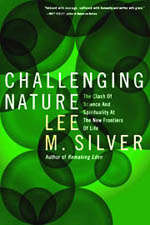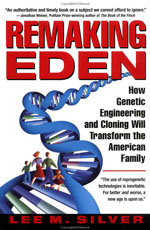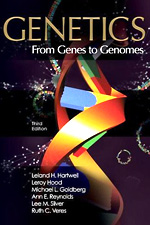|
published by Ecco/Harper Collins, 2006
|
|
Challenging Nature
Previous books
Presentations
Publications/Writings
Biography
Princeton teaching
|
The Reproducers by Lee M. Silver The Sunday New York Times Book Review July 8, 2001 Further reading
Evolution is the most contentious idea in contemporary biology. Half of all Americans don't believe it has anything to do with our appearance on earth, and they'd prefer not to have their children corrupted by its teaching. At the same time, an understanding of evolution has never been more important to scientists of many stripes who use it to gain deeper and richer insights into all aspects of life from biological molecules to whole ecosystems, and from human behavior to human disease. Whether they accept it or not, nearly all American adults have heard of Darwin and his theory. But most don't grasp the principle of "natural selection" that he elucidated. Darwin started with just two basic assumptions. The first is that new heritable changes pop up at random within individual organisms. The second is that certain heritable changes provide individuals with a better chance at surviving and reproducing in competition with their neighbors. Surprisingly, if you accept these two assumptions as facts -- and they are facts of the entire past history of life on earth -- you must accept evolution as a logical consequence. We now understand that heritable changes result from mutations that produce new versions of genes. If a particular new gene causes individuals to propagate (on average) more children, then with each generation, greater and greater proportions of the population will carry the new gene until eventually, it is found in all individuals. In the language of evolution, this gene has been "selected" by nature. However, sooner or later, an even newer gene version will appear that allows individuals to out-compete those with the original new gene version. This never-ending process of one-upmanship is ongoing simultaneously at thousands of genes in every population of living creatures. While the basic principles of Darwinian evolution are simple, the devil -- as well as the delight -- is in the details. And it is the fascinating details and imagined devils that are the basis for a never-ending stream of books on the subject. Some make for beautiful reading. Stephen Jay Gould's earliest popular books charmed readers with lucid descriptions of the evidence for evolution in dead fossils and living animals. Matt Ridley (no relation to the author of the book under review) explored the scandalous impact of evolution on the different ways that men and women behave, and the consequences of that behavior for human society and the economy. Jonathan Weiner's "The Beak of the Finch" won a Pulitzer Prize for its portrayal of a modern-day Darwin-like husband-and-wife team who found real-time evolution occurring in the same archipelago that made Charles Darwin famous. Mark Ridley's "The Cooperative Gene" is the latest in the stream. While other authors shower their attention on the macro-world of individuals and societies, Ridley focuses on the bizarre battles that occur within the micro-world of the cell and its chromosomes. To understand the source of turmoil in this micro-world, it is first necessary to appreciate a major problem in the Darwinian view of evolution that Darwin himself recognized. Natural selection should favor only those individuals who are best able to survive and reproduce themselves. "Nice guys" who squander precious time and energy to help others should finish last, which means that we shouldn't find them in existence today. So how do we explain the male praying mantis who gets one chance to copulate with a female before she eats him up, literally. And how come ant and bee colonies are filled mostly with workers who never reproduce at all? An explanation for these and many other organismal behaviors that go against the "survival of the fittest" dictum came through a startling new interpretation of natural selection, first popularized in Richard Dawkins' brilliant, and now-classic, 1976 book, "The Selfish Gene." People often assume that individual animals, like ourselves, are the centerpiece of evolution, but the longest-lived individuals survive for a miniscule speck of time in the grand scheme of life. The only thing that can survive longer is a clever gene. It was not until the 1960's that evolutionary biologists began to recognize the implication of these facts. They realized that genes were not being used by organisms as much as organisms were being used by their genes. It is the genes that are competing with each other. It is the "selfish gene," not individual organisms, that can survive for millions of years. The gene's eye view of the world is very different from that of the organism simply because a successful gene can place itself into a whole group of genetic relatives. In the gene's eye view, it makes perfect sense to sacrifice some of those relatives when the sacrifice helps to increase the gene's survival and replication through other relatives. This logic is amenable to a precise mathematical formulation that explains all sorts of biological phenomena in which individual organisms express instinctive behaviors that are antithetical to their own personal survival or reproduction. Praying mantis genes sacrifice post-copulatory males so that better-nourished females can produce more copies of praying mantis genes. Bee genes organize large colonies of sterile workers for the sole purpose of assisting the queen in her production of large quantities of bee genes (that happen to reside inside bee bodies). As Ridley explains, sex also begins to make sense in light of the selfish gene. If the organism really mattered, we would expect it to reproduce by cloning. Instead, almost all complex organisms compromise their reproduction by putting only half their genes into their offspring together with someone else's genes. From the gene's eye perspective, however, sex provides an opportunity to get placed into multiple organisms, in the company of different combinations of other genes. Each time an organism is formed, the genetic equivalent of thousands of dice are thrown. The odds are that a small number of offspring will be winners because they avoid harmful new mutations but carry a unique genetic combination that happens to be well-suited for outrunning viruses and other germs. Sex sacrifices all the losing siblings. The selfish gene theory has been misconstrued by some as a genetic license to act in purely selfish ways. In fact, it is the gene's eye view of the world that provides the best evolutionary explanation for the instinctive expression of altruism, morality, societal cooperation, and even love. But there's a delicate balance between cooperation and conflict at all levels of life from societies to cells. Within the micro-world of the cell, the selfishness of single genes is normally tempered by their need to cooperate with neighboring genes in construction of the bodies that reproduce them all. However, as Ridley explains, genes can become ruthless at the micro-level when the opportunity arises. In some species of mice and flies, there is a deceitful gang of genes that quietly cooperates with its neighbors throughout organismal development until the production of sperm cells. Like other genes, this gang is only placed into half the sperm. But as soon as the division takes place, the gene gang assassinates the brother sperm in which it doesn't reside. As a result, it manages to avoid the reproductive compromise of sex as it transmits itself to all offspring of the males that carry it. It turns out that assassin genes are not very common because their gene victims eventually figure out how to fight back. In Ridley's words, gene justice will always prevail at the end of the day. Ridley tells other tales of attempted gene mutinies. The most fascinating is one that has come to light over the last decade in the form of multiple battles between genes given to a fetus by its father and those provided by its mother. The father's genes direct the fetus to suck up all the mother's resources at the expense of the mother's future health and fertility. But the mother's genes have evolved the ability to counteract each of many hijacking attempts. What we see within our own genomes is a current truce in this ongoing war between the sexes. Ridley ends with speculation on the future evolution of intelligent life, including a bizarre comparison of earthly sex to sex among angels (with details presented in tables on p. 267). The title of Ridley's book suggests that it will be an antidote to "The Selfish Gene" of Richard Dawkins. But, in fact, the ideas presented in "The Cooperative Gene" are not that different from those of Dawkins, and they've been expressed in more lively prose by Dawkins and other authors. Like the Exodus from Egypt, the story of evolution must be told anew to each generation. In both cases, however, it is probably best to rely on earlier texts. Lee M. Silver is a professor of molecular biology and public affairs at Princeton University and the author of "Remaking Eden: How Cloning and Genetic Engineering will Transform the American Family." |
Hover over or click on books to order from Amazon.com
|



